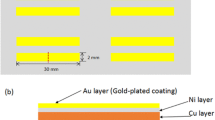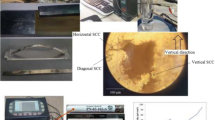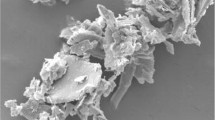Abstract
Pitting susceptibility of metals in corrosive environment is usually measured using a three-electrode set-up to conduct accelerated corrosion tests. A widely accepted methodology consists in mounting a sample in epoxy resin and connect it with a copper wire. However, in chloride-rich environments, this often results in the occurrence of crevice corrosion instead of pitting. In this study, a new 3D-printed sample holder was designed and its efficiency to study pitting corrosion of metals validated. The new method enables to study of pitting corrosion by improving edge enclosure, thus avoiding crevice corrosion. The validation is based on two case studies where stainless steel samples are polarized in (i) 500-ppm Cl− at ambient temperature and (ii) saturated Ca(OH)2 with 1-M Cl− at 60 °C. The specifically chosen grade (AISI 316 L) shows failure of the electrode clearly initiated at the epoxy sample edge in traditional tests and poor reproducibility. Results showed that the use of the 3D-printed sample holder significantly improved the reliability and efficiency of the testing method, clearly avoiding unrealistic crevice corrosion in the tested conditions. The designed sample holder therefore enables more realistic and representative pitting results in corrosion research opening the possibility of conducting far less-expensive repetitive tests.
Graphical abstract










Similar content being viewed by others
References
Esmailzadeh S, Aliofkhazraei M, Sarlak H (2018) Interpretation of cyclic potentiodynamic polarization test results for study of corrosion behavior of metals: a review. Prot Met Phys Chem Surf 54:976–989. https://doi.org/10.1134/S207020511805026X
Galvele JR (2005) Tafel’s law in pitting corrosion and crevice corrosion susceptibility. Corros Sci 47:3053–3067. https://doi.org/10.1016/j.corsci.2005.05.043
Song G-L, Xu Z (2012) Crystal orientation and electrochemical corrosion of polycrystalline Mg. Corros Sci 63:100–112. https://doi.org/10.1016/j.corsci.2012.05.019
Zhang J, Yuan J, Qiao Y et al (2003) The corrosion and passivation of SS304 stainless steel under square wave electric field. Mater Chem Phys 79:43–48. https://doi.org/10.1016/S0254-0584(02)00445-5
Shen J, Song G, Zheng D, Wang Z (2019) A double-mode cell to measure pitting and crevice corrosion. Mater Corros 70:2228–2237. https://doi.org/10.1002/maco.201910932
ASTM G150-13 (2013) Standard test method for electrochemical critical pitting temperature testing of stainless steels. ASTM International, West Conshohocken
Vanegas M, Wang K, Iannuzzi M (2022) Technical note: methodology development to study two-dimensional stainless steel pitting corrosion mechanisms using foil samples. Corrosion 78(6):473–478. https://doi.org/10.5006/4057
Panindre AM, Frankel GS (2021) Technical note: electrochemical testing for pitting corrosion above ambient temperatures using the syringe cell. Corrosion 77(9):1025–1028. https://doi.org/10.5006/3854
Ovarfort R (1988) New electrochemical cell for pitting corrosion testing. Corros Sci 28:135–140. https://doi.org/10.1016/0010-938X(88)90090-X
Husain A, Brahme PS, Al-Shamali O (2007) Development of a modified test cell for AC impedance testing of coated Al fins. J Coat Technol Res 4:317–325. https://doi.org/10.1007/s11998-007-9043-y
Berner M, Liu H-P, Olsson C-OA (2008) Estimating localised corrosion resistance of low alloy stainless steels: comparison of pitting potentials and critical pitting temperatures measured on lean duplex stainless steel LDX 2101 after sensitation. Corros Eng Sci Technol 43:111–116. https://doi.org/10.1179/174327808X286347
Ghayad IM, Hamada AS, Girgis NN, Ghanem W (2004) Effect of cold working on the aging and corrosion behavior of Fe-Mn-Al stainless steel. Nice, France, p 10
Cardoso JL, Silva Nunes Cavalcante AL, Araujo Vieira RC et al (2016) Pitting corrosion resistance of austenitic and superaustenitic stainless steels in aqueous medium of NaCl and H2SO4. J Mater Res 31:1755–1763. https://doi.org/10.1557/jmr.2016.198
Han D, Jiang YM, Shi C et al (2012) Effect of temperature, chloride ion and pH on the crevice corrosion behavior of SAF 2205 duplex stainless steel in chloride solutions. J Mater Sci 47:1018–1025. https://doi.org/10.1007/s10853-011-5889-6
Kennell GF, Evitts RW, Heppner KL (2008) A critical crevice solution and IR drop crevice corrosion model. Corros Sci 50:1716–1725. https://doi.org/10.1016/j.corsci.2008.02.020
ASTM G61-86 (2018) Standard test method for conducting cyclic potentiodynamic polarization measurements for localized corrosion susceptibility of iron-, nickel-, or cobalt-based alloys. ASTM International, West Conshohocken
ASTM G5-94 (2004) Standard reference test method for making potentiostatic and potentiodynamic anodic polarization measurements. ASTM International, West Conshohocken
Somrerk CA, Wachirasiri W, Lothongkum G (2013) Effects of chloride and sulphate ions on the experimental E-pH diagrams of AISI 316L stainless steel in deaerated aqueous solutions. Adv Mat Res 813:443–446. https://doi.org/10.1002/maco.201910932
Lothongkum G, Vongbandit P, Nongluck P (2006) Experimental determination of E-pH diagrams for 316L stainless steel in air‐saturated aqueous solutions containing 0‐5,000 ppm of chloride using a potentiodynamic method. Anti-corros Method Mater 53:169–174. https://doi.org/10.1108/00035590610665581
Refaey SAM, Taha F, Abd Al-Malak AM (2006) Corrosion and inhibition of 316L stainless steel in neutral medium by 2-mercaptobenzimidazole. Int J Electrochem Sci. https://doi.org/10.20964/1020080
King F (2009) Corrosion resistance of austenitic and duplex stainless steels in environments related to UK geological disposal. Quintessa Limited, Oxfordshire, United Kingdom
Olssen CAO (2018) Wet corrosion of stainless steels and other chromium-bearing alloys. Encyclopedia of interfacial chemistry: surface science and electrochemistry encyclopedia of interfacial chemistry: surface science and electrochemistry. Elsevier, Amsterdam, pp 535–542
Huang T-S, Tsai W-T, Pan S-J, Chang K-C (2018) Pitting corrosion behaviour of 2101 duplex stainless steel in chloride solutions. Corros Eng Sci Technol 53:9–15. https://doi.org/10.1080/1478422X.2017.1394020
Klapper HS, Stevens J, Wiese G (2013) Pitting corrosion resistance of CrMn Austenitic stainless steel in simulated drilling conditions—role of pH, temperature, and chloride concentration. Corrosion 69:1095–1102. https://doi.org/10.5006/0947
Elsener B, Addari D, Coray S, Rossi A (2011) Stainless steel reinforcing bars - reason for their high pitting corrosion resistance. Mater Corros 62:111–119. https://doi.org/10.1002/maco.201005826
Gastaldi M, Bertolini L (2014) Effect of temperature on the corrosion behaviour of low-nickel duplex stainless steel bars in concrete. Cem Concr Res 56:52–60. https://doi.org/10.1016/j.cemconres.2013.11.004
Moser RD, Singh PM, Kahn LF, Kurtis KE (2012) Chloride-induced corrosion resistance of high- strength stainless steels in simulated alkaline and carbonated concrete pore solutions. Corros Sci 57:241–253. https://doi.org/10.1016/j.corsci.2011.12.012
Blanco G, Bautista A, Takenouti H (2006) EIS study of passivation of austenitic and duplex stainless steels reinforcements in simulated pore solutions. Cem Concr Comp 28:212–219. https://doi.org/10.1016/j.cemconcomp.2006.01.012
Paredes EC, Bautista A, Alvarez SM, Velasco F (2012) Influence of the forming process of corrugated stainless steels on their corrosion behaviour in simulated pore solutions. Corros Sci 58:52–61. https://doi.org/10.1016/j.corsci.2012.01.010
Mesquita TJ, Chauveau E, Mantel M et al (2012) Lean duplex stainless steels—The role of molybdenum in pitting corrosion of concrete reinforcement studied with industrial and laboratory castings. Mater Chem Phys 132:967–972. https://doi.org/10.1016/j.matchemphys.2011.12.042
Saadawy M (2012) Kinetics of pitting dissolution of austenitic stainless steel 304 in sodium chloride solution. ISRN Corros 2012:1–5. https://doi.org/10.5402/2012/916367
Alonso-Falleiros N, Wolynec S (2002) Correlation between corrosion potential and pitting potential for AISI 304L austenitic stainless steel in 3.5% NaCl aqueous solution. Mater Res 5:77–84. https://doi.org/10.1590/S1516-14392002000100013
Xu C, Zhang Y, Cheng G, Zhu W (2008) Pitting corrosion behavior of 316L stainless steel in the media of sulphate-reducing and iron-oxidizing bacteria. Mater Charact 59:245–255. https://doi.org/10.1016/j.matchar.2007.01.001
He L, Wang Y, Singh PM (2017) Pitting behavior of lean duplex stainless steels in thiosulfate- containing paper machine environment. New Orleans, United States of America
Shet N, Nazareth R, Suchetan PA (2019) Corrosion inhibition of 316 stainless steel in 2 M HCl by 4- {[4-(dimethylamino)benzylidene]amino}-5-methyl-4H-1,2,4-triazole-3-thiol. Chem Data Collect 20:100209. https://doi.org/10.1016/j.cdc.2019.100209
Abdallah M, Salem MM, Al Jahdaly BA et al (2017) Corrosion inhibition of stainless steel type 316 L in 1.0 M HCl solution using 1,3-thiazolidin-5-one derivatives. Int J Electrochem Sci 12:4543–4562. https://doi.org/10.20964/2017.05.35
Abdallah M, Hazazi OA, Fouda AS, Abdel-Fatah A (2015) Corrosion inhibition of stainless steel type 316L in hydrochloric acid solution using p-aminoazobenzene derivatives. Prot Met Phys Chem Surf 51:473–480. https://doi.org/10.1134/S2070205115030028
Stansbury EE, Buchanan RA (2000) Fundamentals of electrochemical corrosion. ASM International, Materials Park, OH
Kelly RG (2003) Electrochemical techniques in corrosion science and engineering. Marcel Dekker, New York
Lopes RHC (2011) Kolmogorov-Smirnov test. International encyclopedia of statistical science. Springer, Berlin, Germany, pp 718–720
Acknowledgements
The authors would like to thank the Belgian Agency for Radioactive Waste and Enriched Fissile Materials (ONDRAF/NIRAS) for the financial support. The Private Foundation De Nayer is kindly thanked for funding the electrochemical potentiostat.
Funding
The present study is supported by the Belgian Agency for Radioactive Waste and Enriched Fissile Materials (ONDRAF/NIRAS) and the Private Foundation De Nayer.
Author information
Authors and Affiliations
Contributions
Conceptualization: RD, WB, and BR; Methodology: BV, MN, and WB; Formal analysis and investigation: BV and MN; Writing—original draft preparation: BV and PVanA; Writing—review and editing: PVanA, RG, BR, WB, and RD; Funding Acquisition: RD and WB; Supervision: RG, RD, and WB.
Corresponding author
Ethics declarations
Conflict of interest
The authors have no conflicts of interest to declare that are relevant to the content of this article.
Additional information
Publisher’s Note
Springer Nature remains neutral with regard to jurisdictional claims in published maps and institutional affiliations.
Supplementary Information
Below is the link to the electronic supplementary material.
Rights and permissions
Springer Nature or its licensor (e.g. a society or other partner) holds exclusive rights to this article under a publishing agreement with the author(s) or other rightsholder(s); author self-archiving of the accepted manuscript version of this article is solely governed by the terms of such publishing agreement and applicable law.
About this article
Cite this article
Verhoeven, B., Nagels, M., Van Aken, P. et al. A new methodology to efficiently test pitting corrosion: design of a 3D-printed sample holder to avoid the occurrence of crevice corrosion in chemically aggressive media. J Appl Electrochem 53, 167–176 (2023). https://doi.org/10.1007/s10800-022-01759-x
Received:
Accepted:
Published:
Issue Date:
DOI: https://doi.org/10.1007/s10800-022-01759-x




